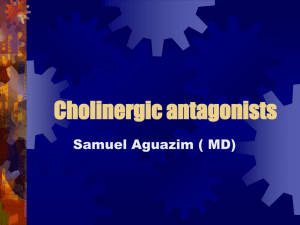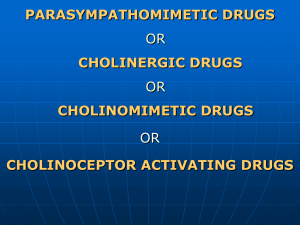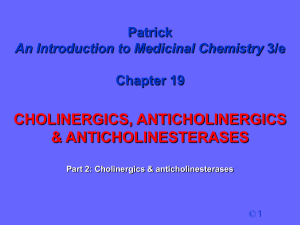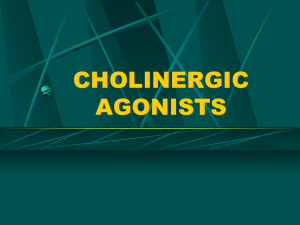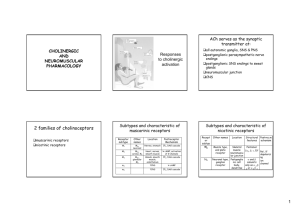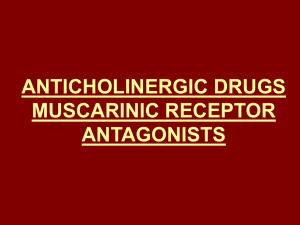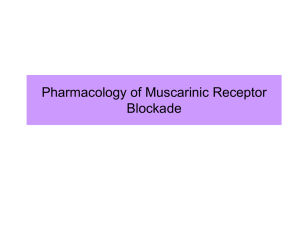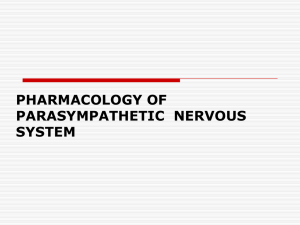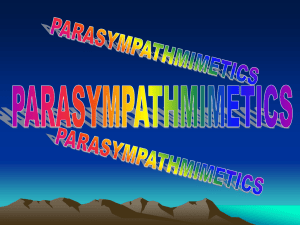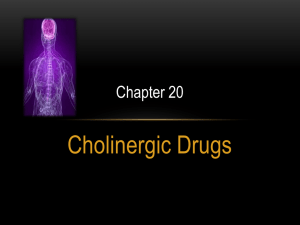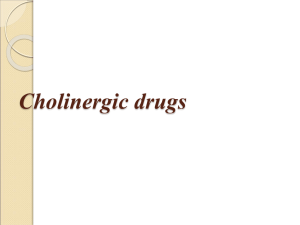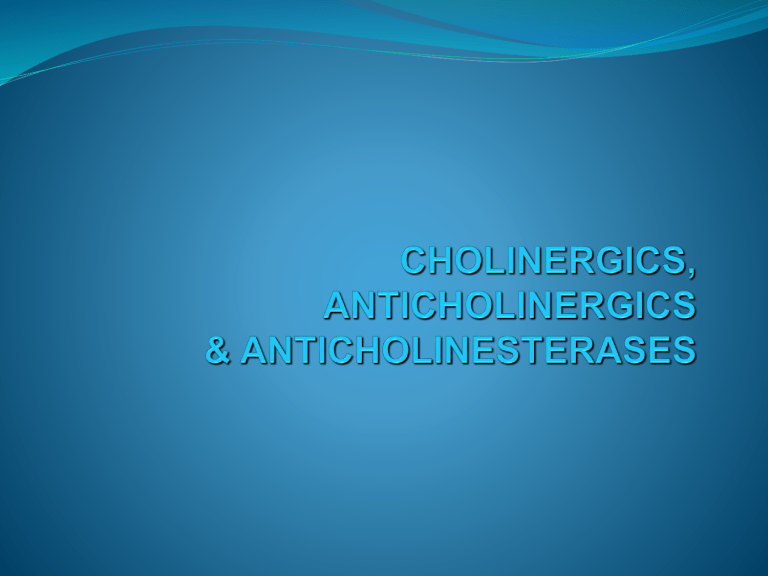
Overview of Nervous System
Parasympathetic Responses
Motor nerves
Without motor nerves:
No breathing.
Digestion.
Excretion.
Muscle movement.
Control of body temperature.
Heart problems.
Motor nerves
Somatic motor NS:
1.
carry messages from CNS to the skeletal muscles.
Acetylcholine is the neurotransmitter.
Lead to muscle contraction.
Motor nerves
2. Autonomic motor NS:
Carry messages from the CNS to smooth muscle,
cardiac muscle and adrenal medulla.
Two subsystems:
I.
II.
1. Parasympathetic nerves:
From CNS to smooth muscles.
Acetylcholine is the N.T.
2. Sympathetic nerves:
To the cardiac muscles and most of internal organs.
Using Noradrenalin and Acetylcholine as N.T
Adrenaline action
increase heart rate.
Relax GIT and UT muscles.
Decrease salivation.
Vasoconstriction of peripheral blood vessels.
Fight or Flight
Motor nerves
3. Enteric NS:
Located in the wall of intestine.
Use serotonin, neuropeptide, Acetylcholine and
Dopamine are among many other neurotransmitters
take part in this system
Nerve Impulse Transmission
Nerve Impulse Transmission
Acetylcholine combines with cholinergic
receptors
Nicotinic
Excitatory response
Muscarinic
Excites or inhibits
SAR for acetylcholine
Quaternary nitrogen is essential
O
H3C
O
O
CMe3
Bad for activity
H3C
O
NMe2
SAR for acetylcholine
•
•
Distance from quaternary nitrogen to ester is important
Ethylene bridge must be retained
O
O
H 3C
O
NMe3
H 3C
Bad for activity
O
NMe3
SAR for acetylcholine
Ester is important
H 3C
O
NMe3
H 3C
Bad for activity
NMe3
SAR for acetylcholine
Minimum of two methyl groups on quaternary nitrogen
O
O
H 3C
Et
Et
O
N
Et
H 3C
O
Me
Me
Et
Lower activity
N
Active
SAR for acetylcholine
Methyl group of acetoxy group cannot be extended
O
H 3C
O
Much lower activity
NMe3
SAR for acetylcholine
Conclusions:
• Tight fit between Ach and binding site
• Methyl groups fit into small hydrophobic pockets
• Ester interacting by H-bonding
• Quaternary nitrogen interacting by ionic bonding
Binding site (muscarinic)
hydrophobic
pocket
CH3
Trp-307
Asp311
CH3
CO 2
N
O
O
Trp-616 Trp-613
H
O
N
Asn-617
H
CH3
hydrophobic
pockets
CH3
hydrophobic
pocket
Binding site (muscarinic)
Trp-307
vdw
CH3
Ionic bond
Asp311
CO 2
N
O
CH3
CH3
vdw
O
H-bonds
H
O
N
Asn-617
H
Trp-616 Trp-613
CH3
vdw
Cholinergic Agents
Direct acting - act on the receptors to activate a tissue
response
Indirect acting - inhibit the action of the enzyme
Acetylcholinesterase:
Major uses = Stimulate bladder & GI tone, constrict
pupils (miosis),
neuro-muscular transmission
Hydrolysis of Acetylcholine
Acetylcholine (Ach)
Acetyl
Choline
Cholinergic receptors
Muscarinic receptors:
1.
Found in smooth muscles and cardiac muscles.
Related to muscarine.
2. Nicotinic receptors:
Found in skeletal muscles.
Related to nicotine.
Subtypes of M1
M- receptor Neural
M2
Cardiac
M3
Glandular,
smooth muscles
M4
M5
Main
location
CNS, Gastric &
salivary glands
Heart , GIT,
CNS
Gastric &
salivary glands,
GIT, Eye
CNS
CNS
Cellular
response
Increase IP3,
DAG,
Depolarization,
excitation,
increase
potassium
conductance
Decrease in
a) cAMP
inhibition,
b) Ca++
conductance,
Increase K+
conductance
Increase IP3,
Ca++
conductance,
As M2
As M3
Functional
responses
CNS excitation, Cardiac
gastric secretion inhibition,
neural
inhibition
Gastric & saliva
secretion, GI
smooth muscle
contraction,
occular
accomodation
Enhanced
locomotion
Not
known
Cholinergic agonists
Acetylcholine as an agonist
Advantages
•
Natural messenger
•
Easily synthesised
Disadvantages
•
Easily hydrolysed in stomach (acid catalysed hydrolysis)
•
Easily hydrolysed in blood (esterases)
•
No selectivity between receptor types
•
No selectivity between different target organs
L-serine
choline
ethanolamine
Acetylcholine
Biological hydrolysis of Ach
What makes acetylcholine exceptionally prone to hydrolysis
is the possibility of folding to form an intramolecular dipole
bond that will increase the positive charge of the ester carbonyl
Cholinergic agonists
Nicotine and muscarine as cholinergic agonists
Advantages
•
•
•
More stable than Ach
Selective for main cholinergic receptor types
Selective for different organs
Disadvantages
•
Activate receptors for other chemical messengers
•
Side effects
Cholinergic agonists
Requirements for cholinergic agonists
•
Stability to stomach acids and esterases
•
Selectivity for cholinergic receptors
•
Selectivity between muscarinic and nicotinic receptors
•
Knowledge of binding site
•
SAR for acetylcholine
Active conformation of acetylcholine
•
Defines separation of ester and N
O
4.4A
O
5.9A
N
N
Muscarinic
receptor
Nicotinic
receptor
Uses of cholinergic agonists
Nicotinic selective agonists
Treatment of myasthenia gravis
- lack of acetylcholine at skeletal muscle causing weakness
Muscarinic selective agonists
•
Treatment of glaucoma
•
Switching on GIT and urinary tract after surgery
•
Treatment of certain heart defects. Decreases heart muscle
activity and decreases heart rate
Design of cholinergic agonists
Use of steric shields
Rationale
Bulky groups
•
Shields protect ester from nucleophiles and enzymes
•
Shield size is important
•
Must be large enough to hinder hydrolysis
•
Must be small enough to fit binding site
Acetylcholine analogues
To overcome the instability of Ach:
Steric shield: add large group to change the
conformation of Ach:
3X more stable than Ach.
More selective on muscarinic over nicotinic receptors.
S-enantiomer is more active than the R-enantiomer
Design of cholinergic agonists
Use of electronic factors
•
Replace ester with urethane (Carbamate) group will stabilises
the carbonyl group
Acetylcholine analogues
Carbamate more stable ester toward hydrolysis (why?)
NH2 and CH3 are equal sizes. Both fit the hydrophobic
pocket
Long acting cholinergic agonist.
Can be administered orally.
Not selective…… just used topically in glaucoma.
Acetylcholine analogues
More stable.
More selective on muscarinic receptor.
Used to stimulate GIT and urinary bladder
after surgery.
Muscarinic agonists
Clinical uses:
Treatment of glaucoma.
Stimulate GIT and UT after surgery.
In some heart defects.
Pilocarpine:
An alkaloids from Pilocarpus shrubs.
Used in glaucoma.
Topically only (why?)
Muscarinic agonists
Oxotremorine and Arecoline:
Act on the muscarinic receptors in brain.
Used in Alzheimer’s disease.
Nicotinic agonists
Mainly used in myasthenia gravis: an autoimmune
disorder in which the body produce antibodies against
cholinergic receptors.
Cholinergic Antagonists
Of two types:
Muscarinic antagonists:
The prototype drug here is Atropine
Cholinergic Antagonists
Nicotinic antagonists:
The prototype drug is tubocurarine
MeO
Me
N
HO
Me
H
O
Me
H
H
CH2
CH2
O
N
OH
OMe
What do we mean by Antagonists
Antagonist is a molecule that can bind to a
receptor without eliciting a response:
it does not activate the receptor
it will block the binding site
Prevents the entrance of the natural ligand of
that receptor
Based on this definition
The chemical structure of receptor antagonist does not
necessarily mimic the natural ligand structure;
Antagonist is generally bulkier,
having
extra
binding
groups
compared to the natural ligand
Different binding mode, means no
formation of the receptor active
conformer…no response
Muscarinic Antagonists
Clinical Effects
• Decrease of saliva and gastric
secretions
• Relaxation of smooth muscle
• Decrease in motility of GIT and urinary
tract
• Dilation of pupils
Muscarinic Antagonists
Uses
• Shutting down digestion for surgery
• Ophthalmic examinations
• Relief of peptic ulcers
• Treatment of Parkinson’s Disease
• Anticholinesterase poisoning
• Motion sickness
Nicotinic Antagonists
Normally used as muscle relaxant.
Clinical uses:
• Neuromuscular blocker for surgical
operations
• Permits lower and safer levels of general
anaesthetic
Muscarinic Antagonists
easily racem
Atropine
•
•
•
•
•
•
Racemic form of hyoscyamine
Source - roots of belladonna
Used as a poison
Used as a medicine
decreases GIT motility
antidote for Anticholinesterase poisoning
dilation of eye pupils
CNS side effects – hallucinations
Common side effects: urinary retention and blurred vision.
Muscarinic Antagonists
• Ophthalmic use of atropine a as mydriatic (dilating) agent has been
largely replaced by use of analogs tropicamide and cyclopenatolate.
• However, atropine, and its chiral analog hyoscyamine, are utilized to
treat gastrointestinal disorders
• Also these antagonists can be used to treat the symptoms of an excess
cholinergic activity, such as the exposure to an acetylcholinesterase
inhibitor (such as a nerve gas).
Atropine
NMe3
CH2
CH2
O
C
CH3
O
•
•
•
•
•
•
Relative positions of ester and nitrogen similar in both molecules
Nitrogen in atropine is ionised
Amine and ester are important binding groups (ionic + H-bonds)
Aromatic ring of atropine is an extra binding group (vdW)
Atropine binds with a different induced fit - no activation
Atropine binds more strongly than acetylcholine
Analogues of atropine
•
•
•
Analogues are fully ionised
Analogues unable to cross the blood brain barrier
No CNS side effects
Muscarinic Antagonists
Hyoscine (scopolamine):
Used in motion sickness and as antispasmodic.
Same side effects as atropine.
Is it more toxic than atropine?
The combination preparation ipratropium/salbutamol is a formulation
containing ipratropium bromide and salbutamol sulfate (albuterol sulfate)
used in the management of chronic obstructive pulmonary disease
(COPD) and asthma (Combivent®).
Muscarinic Antagonists
Pharmacophore = ester + basic amine + aromatic ring
Used in excessive sweating,
spasms and nocturnal
enuresis.
Muscarinic Antagonists
Simplified Analogues
Tropicamide
(opthalmics)
Cyclopentolate
(opthalmics)
O
HN
N
N
C
Benztropine
(Parkinsons disease
and ulcer)
N
C
O
CH2
CH
N
Benzhexol
(Parkinsons disease)
N
Me
Pirenzepine
(anti-ulcer)
Tropicamide
Cyclopentolate
• Tropicamide and Cyclopentolate are among the most commonly employed
mydriatic (dilating) and cycloplegic (paralyzing) agents
• Both function as antagonists at the muscarinic acetylcholine receptors
Muscarinic Antagonists
SAR for Antagonists
Important features
•
Tertiary amine (ionised) or a quaternary nitrogen
•
Aromatic ring
•
Ester
•
N-Alkyl groups (R) can be larger than methyl (unlike agonists)
•
Large branched acyl group
•
R’ = aromatic or heteroaromatic ring
•
Branching of aromatic/heteroaromatic rings is important
Muscarinic Antagonists
SAR for Antagonists
Me
Me
CH
O
O
C
CH2CH2 N
O
Me
CH
C
Me
Me
CH2
O
Cl
Active
Inactive
O
CH2 CH2NR2
Proposed Binding Site for Antagonists
O
C
O
CH2
CH2
CO 2
NMeR2
O
H2N
Asn
Nicotinic Antagonists
Curare
•
•
•
•
Extract from curare plant (Chondodendron tomentosum)
Used for poison arrows
Causes paralysis (blocks acetylcholine signals to muscles)
Active principle = tubocurarine
MeO
Me
N
HO
Me
H
O
Me
H
H
CH2
CH2
Tubocurarine
O
N
OH
OMe
Native Indians hunting animals with this poison
were able to eat the animal's contaminated flesh
without being affected by the toxin because
tubocurarine cannot easily cross mucous
membranes and is thus inactive orally.
Nicotinic Antagonists
Pharmacophore
•
•
•
Two quaternary centres at specific separation (1.15nm)
Different mechanism of action from atropine based
antagonists
Different binding interactions
Clinical uses
•
•
•
Neuromuscular blocker for surgical operations
Permits lower and safer levels of general anaesthetic
Tubocurarine used as neuromuscular blocker
Nicotinic Antagonists
Analogues of tubocurarine
•
•
•
•
Long lasting
Long recovery times
Side effects on heart
No longer in clinical use
•
•
•
•
•
Esters incorporated
Shorter lifetime (5 min)
Fast onset and short duration
Frequently used during intubation
Side effects at autonomic ganglia
Nicotinic Antagonists
Analogues of tubocurarine
•
•
•
•
Steroid acts as a spacer for the quaternary centres (1.09nm)
Acyl groups are added to introduce the Ach skeleton
Faster onset than tubocurarine but slower than suxamethonium
Longer duration of action than suxamethonium (45 min)
• Pancuronium is used to block the neuromuscular junction during surgery or
intubation.
• In the US, Pancuronium (Pavulon) is the second of three drugs used in execution by
lethal injection
Nicotinic Antagonists
Analogues of tubocurarine
•
•
•
•
•
•
Design based on tubocurarine and suxamethonium
Lacks cardiac side effects
Rapidly broken down in blood both chemically and metabolically
Avoids patient variation in metabolic enzymes
Lifetime is 30 minutes (Self destruct system limits lifetime)
Administered as an i.v. drip
Atracurium instability
• Atracurium is stable under acid pH
• But unstable under blood pH due to
Hofmann elimination
Analogues of tubocurarine
•
•
Faster onset (2 min)
Shorter duration (15 min)
No chance for Hoffmann elimination (WHY?)
Anticholinesterase agents
Lead to Ach accumulation… have cholinergic effect.
Types of cholinesterase enzymes
Acetylcholinesterase
Located in synapses
Substrate selectivity:
Ach
Plasma cholinesterase
Located in plasma
(non-neuronal)
Substrate selectivity:
Ach
Succinylcholine
Local anesthetics (procaine)
Anticholinesterase agents
R
CH3
C2H5
C3H7
C4H9
Relative Potency
1.0
5.0
100
50
Tetraalkylammonium ion
Bind to anionic site and block Ach binding
Reversible
Anticholinesterase agents
Anticholinesterase agents
Either reversible or irreversible inhibition.
1. Carbamate:
Systemically toxic (why?).
Use in Glaucoma, myasthenia gravis and Alzheimer’s.
Used as antidote for atropine poisoning (why?)
SAR:
Carbamate is essential.
Benzene ring is important.
Pyrrolidine ring is important.
What are the possible side effects?
Anticholinesterase agents
Physostigmine analogues:
has CNS side effects.
Neostigmine has less CNS side effects and more stable
than miotine (why).
Both used in myasthenia gravis.
Anticholinesterase agents
Same profile as neostigmine.
was used by troops to protect against nerve gases.
Is it orally available?
In which dosage form will be administered?
Irreversible Acetylcholinesterase inhibitors
Organophosphates
Irreversible binding to Cholinesterase active site
Longer acting
Used in the treatment of glaucoma
Irreversible Acetylcholinesterase inhibitors
Organophosphates Nerve gases
Irreversible binding to AchE
Irreversible Acetylcholinesterase inhibitors
Organophosphates Insecticides
Irreversible binding to AChE
Rapidly inactivated in mammals compared to insects
Carboxyesterase
Mammals, Birds
Antidote for AchE “poisoning”
Pralidoxime chloride
Cl-
(Protopam;PAM)
Antidote for pesticide or
nerve gas poisoning
Most effective if given
within a few hours of
exposure
Clinical Uses of acetylcholinesterase
inhibitors

